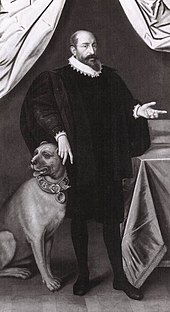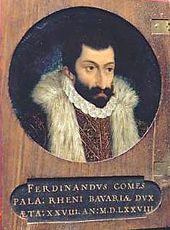Ferdinand of Bavaria (1550–1608)

Ferdinand von Bayern (born January 20, 1550 in Landshut , † January 30, 1608 in Munich ) was a Prince of Bavaria , general and founder of the Wittelsbach branch of the Counts of Wartenberg , the so-called Ferdinandine line of the Bavarian ruling house.
Life
Ferdinand was a son of Duke Albrecht V of Bavaria (1528–1579) from his marriage to Archduchess Anna of Austria (1528–1590), the second daughter of Emperor Ferdinand I.
As a later son, Ferdinand was initially intended for a spiritual career, but preferred a military command. He therefore became the leader of the Bavarian troops consisting of 5000 men in the Cologne War, which was successful for Bavaria from 1583 to 1584. In 1584 Ferdinand Godesberg stormed and conquered Bonn . As a result, he succeeded in appointing his younger brother Ernst as Elector of Cologne.
On December 26, 1588 he married Duke Ferdinand, against the opposition of his family, in morganatic marriage , Maria of Pettenbeck , the 15-year-old daughter of the Hague country Judge George of Pettenbeck. Because of the low nobility of his wife, which was not recognized as equal according to the house laws, Ferdinand renounced the succession to the Bavarian throne for himself and his descendants, but received Castle and Gut Wartenberg , annual compensation payments, two knightly estates, as well as the contractual approval of the succession in Bavaria a possible extinction of the descendants of his older brother Wilhelm V.
He also gave the couple at the wedding the Haag county , from which the bride came. In 1602 he raised the children to countesses and counts of Wartenberg . That side line of the Wittelsbach family, also called the so-called "Ferdinandine Line" , became extinct in 1736 in the male line, otherwise it would have a legal claim to the succession in 1777, when the Bavarian Wittelsbach family died out - next to the Palatinate family branches Sulzbach and Zweibrücken , from which all today's Wittelsbachers descend had.
Ferdinand died at the "Schlagfluss" river in Munich, where he and his family lived in a palace on Rindermarkt .
There he also donated the church “St. Nikolaus von Tolentino and St. Sebastian ”, in which he set up his own family funeral. Duke Ferdinand himself was buried in the Frauenkirche after his death , only his heart was buried separately and found its place in the family tomb. However, this is where his wife and most of his descendants found their final resting place. The church was profaned and auctioned in 1807. In 1808 King Maximilian I Joseph ordered the transfer of the 24 Wittelsbachers of the "Ferdinandine Line" (Counts of Wartenberg) buried there to the Frauenkirche, where they are still located today; In 1823 they were put there in new coffins. The new owner of the dissolved church wanted to melt down a life-size Renaissance bronze figure of Duke Ferdinand, created by the court sculptor Hans Krumpper , in order to sell it as scrap metal. This was prevented by a Munich beer brewer, who bought the monument and gave it to the Heilig-Geist-Kirche , where it is now one of the most precious works of art.
progeny
The following children emerged from Ferdinand's marriage to Maria von Pettenbeck, all of whom had the title of Count or Countess von Wartenberg :
- Maria Maximiliana (1589–1638), nun
- Maria Magdalena (1590–1620), nun
- Franz Wilhelm (1593–1661), cardinal, bishop of Osnabrück , Minden , Verden and Regensburg
- Maria Anna (1594–1629), nun
- Sebastian (1595–1596)
- Ernst (1596–1597)
- Ferdinand (1597–1598)
- Maria Elisabeth (1599–1600)
- Maria Renata (1600–1643), nun
- Albrecht (1601-1620)
- Maximilian (1602–1679), Jesuit
- Ernst Benno (1604–1666)
- ⚭ 1628 Countess Euphrosyne Sibylle von Hohenzollern (1607–1636)
- Maria Katharina (1605-1606)
- Ferdinand Lorenz (1606–1666), officer and regimental commander in the Thirty Years War
- ⚭ 1. Anna Juliana von Dachsberg (1611–1650)
- ⚭ 2. 1651 Maria Claudia von Oettingen-Wallerstein (1632–1663)
- Maria Klara (1608–1652), nun and abbess in Cracow
literature
- Friedrich Anton Wilhelm Schreiber: History of the Bavarian Duke Wilhelm V. , JJ Lentner, 1860, p. 101 ff. Online edition of the book, chapter on Ferdinand of Bavaria and his family line
- Andreas Buchner: History of Bavaria: edited from the sources. History of Bavaria during the Reformation and the Thirty Years' War; 1. Book: The times of the Reformation from 1508–1618 , self-published, 1848, Volume 7, pp. 85 ff.
- Susanne Tauss: The knight's hall of the Iburg: on the prince-bishop's residence of Franz Wilhelm von Wartenberg , V&R unipress GmbH, 2007, p. 126 f.
Web links
Individual evidence
- ^ Georg Wilhelm Hopf: Bavarian history in time tables: a manual for teachers, civil servants, as for all friends of patriotic studies , Schmid, 1865, p. 43
- ^ Felix Joseph Lipowsky: Life and government history of the Elector of Bavaria Karl Albert, later Emperor Charles VII , J. Giel, 1830, p. 149
- ↑ On the burial and reburial of the Counts of Wartenberg in Munich
- ↑ Exact description of the Wartenberg Crypt in St. Nikolaus and Sebastian in Munich
| personal data | |
|---|---|
| SURNAME | Ferdinand of Bavaria |
| BRIEF DESCRIPTION | Prince of Bavaria and general |
| DATE OF BIRTH | January 20, 1550 |
| PLACE OF BIRTH | Landshut |
| DATE OF DEATH | January 30, 1608 |
| Place of death | Munich |

